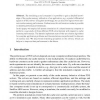Free Online Productivity Tools
i2Speak
i2Symbol
i2OCR
iTex2Img
iWeb2Print
iWeb2Shot
i2Type
iPdf2Split
iPdf2Merge
i2Bopomofo
i2Arabic
i2Style
i2Image
i2PDF
iLatex2Rtf
Sci2ools
117
click to vote
PARA
2004
Springer
2004
Springer
Analyzing Advanced PDE Solvers Through Simulation
Abstract. By simulating a real computer it is possible to gain a detailed knowledge of the cache memory utilization of an application, e.g., a partial differential equation (PDE) solver. Using this knowledge, we can discover regions with intricate cache memory performance. Furthermore, this information makes it possible to identify performance bottlenecks. In this paper, we employ full system simulation of a shared memory computer to perform a case study of three different PDE solver kernels with respect to cache memory performance. The kernels implement state-of-the-art solution algorithms for complex application problems and the simulations are performed for data sets of realistic size. We discovered interesting properties in the solvers, which can help us to improve their performance in the future.
Applied Computing | Cache Memory | Cache Memory Performance | Cache Memory Utilization | PARA 2004 |
Related Content
| Added | 02 Jul 2010 |
| Updated | 02 Jul 2010 |
| Type | Conference |
| Year | 2004 |
| Where | PARA |
| Authors | Henrik Johansson, Dan Wallin, Sverker Holmgren |
Comments (0)

